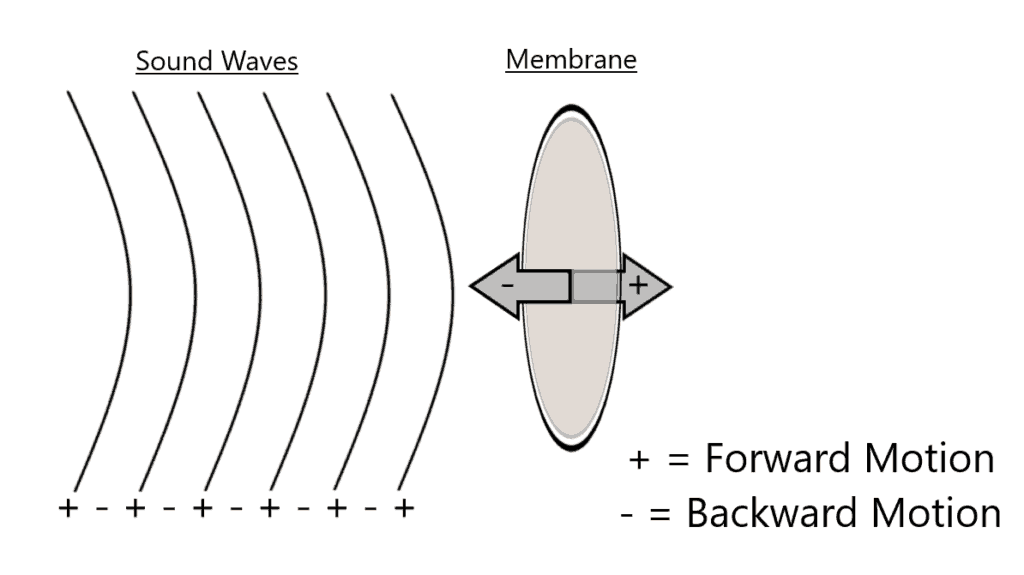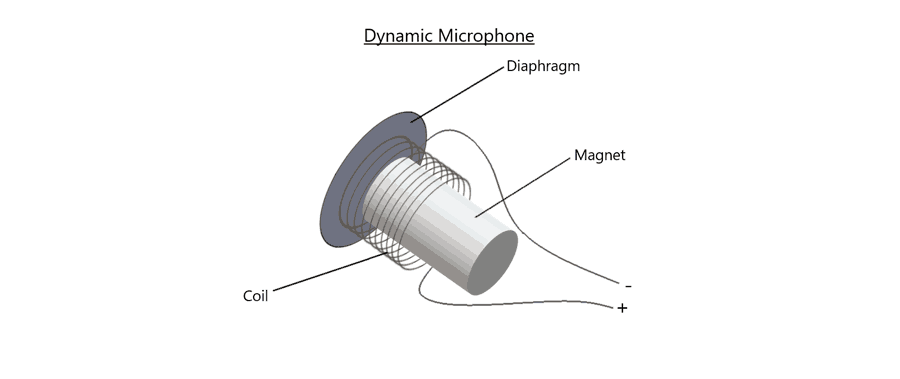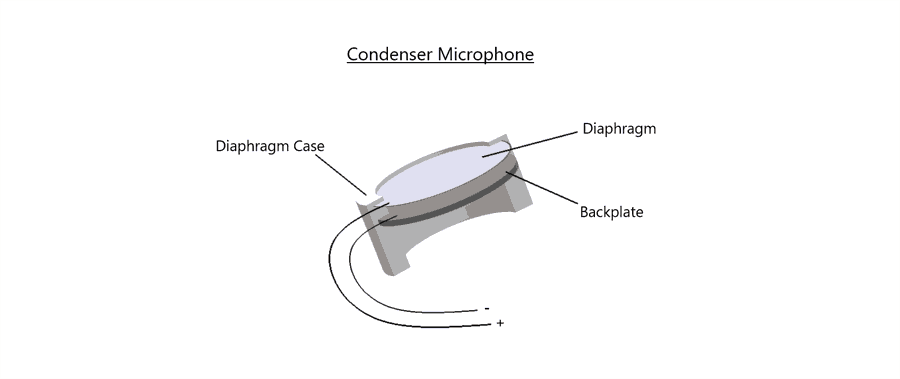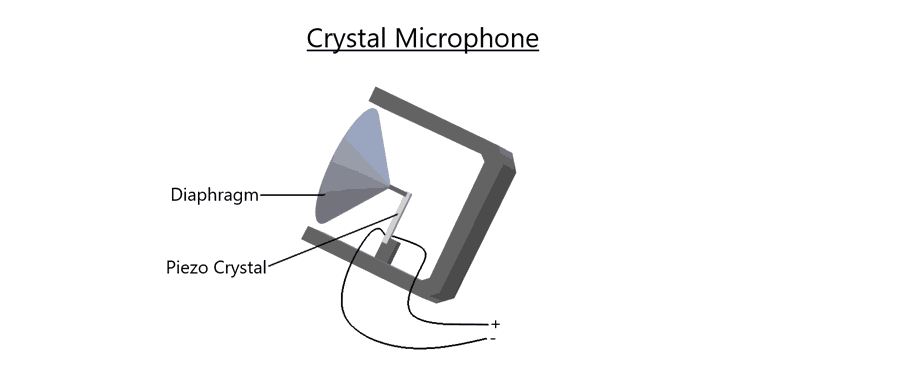
When you are shopping for a microphone, it can be very overwhelming. Where do you start? There are so many different manufacturers and each manufacturer has dozens of options. The best place to start, as with anything in audio, is with the basics.
There are five basic types of microphones: dynamic, condenser, ribbon, carbon, and crystal. In this post, we will explore how each works and what each does best. After reading, you will have a good understanding of the five types, so that you can decide which type to use in different situations.
There are five basic types of microphones: dynamic, condenser, ribbon, carbon, and crystal.
What Is A Microphone?
Despite which type it is, every microphone is a transducer. A transducer is a device which converts energy from one form to another. A microphone converts acoustic energy in the atmosphere to voltage in a cable.
All microphones work on the same basic principle. A membrane in the microphone, called a diaphragm, moves sympathetically with the movement of air particles around it. This mechanism is similar to that of the temporal membrane in the human ear. You can see a simple illustration of this concept below.

The Five Types of Microphones
Although each microphone uses a diaphragm to capture movements in the atmosphere, the method used to convert that movement into electrical currents varies. The following sections explore the five methods.
Dynamic Microphones
How They Work
Dynamic microphones are also called moving coil microphones. They function on the following principle: as a coil of wire moves in relation to a magnet, a voltage is created on the wire.
In a dynamic microphone, the diaphragm is attached to a coil of wire. The coil of wire surrounds a magnet.
The diaphragm is usually made of aluminum alloy or other low-mass material, so that it can be moved by the low-mass particles of the air.
As the diaphragm shifts forward and backward with the movements in the atmosphere, the coil of wire also moves. Because the coil surrounds around a stationary magnet, as the coil moves around the magnet, a voltage is created on the wire. Take a look at the model below.

Speakers operate on this same principle, but in reverse. You can see a detailed animation of how a speaker works by Animagraffs. This is a website that creates amazing 3D models of various technologies.
What They Do Best
Dynamic microphones are the most common type of microphone. The following qualities are what make them so popular:
- Durable
- High-Mass
- Directional
- No Inherent Noise
Durable
Dynamic microphones relatively simplistic in their construction, which makes them more rugged than the more delicate types. Because they are so compactly constructed, the noise from handling a dynamic microphone is greatly reduced.
The Shure SM58, a classic handheld dynamic microphone, is known for its virtual indestructibility. These mics are notorious for their ability to be dropped, tossed, and accidentally hit with drumsticks, while maintaining a consistent sound quality throughout their lifespan.
The durability and rugged construction of moving coil microphones makes them great for live sound applications.
High-Mass
Dynamic microphones are relatively heavy, or massive. This makes them less sensitive than other microphone types. When a microphone has low sensitivity, it means that it can handle a louder input.
More sensitive microphones will sound great for quiet sources, but will start to distort the signal at higher levels. Dynamic microphone diaphragms are generally heavier than the diaphragms in other types of microphones. Although this means they require more gain, it also means they can accurately capture very loud signals without distortion.
If you put a sensitive microphone on a very loud guitar amplifier, snare drum, or horn, for example, the sound will completely overwhelm the diaphragm and cause saturation. These high-output sources require a microphone that can accomodate the sounds they create.
Directional
Dynamic microphones are capable of omnidirectional and cardioid polar patterns.
Most have a cardioid polar pattern, meaning that they pick up sounds best from in front of the diaphragm and reject sounds best from behind the diaphragm. Although other types of microphones are also available with a cardioid polar pattern, dynamic microphones are superior in their ability to reject sounds from the sides and rear.
This has many practical applications.
Firstly, the high directionality of dynamic microphones can help capture only a particular instrument or source, even when other sources of sound are nearby.
Whether you are trying to capture a vocalist standing next to a drum kit, one horn in a brass section, or a podcast guest in a noisy room, the superior directionality of dynamic microphones can be useful.
The directionality of moving coil microphones also helps in sound reinforcement situations.
Any time you send the signal from a microphone to speakers in the same room, there is the danger that the sound from the speakers will enter the microphone and create a feedback loop.
Dynamic microphones are able to provide more gain before feeding back through the speakers. This is another reason they are ideal for live sound.
No Inherent Noise
As you will see in the following sections, some other types of microphones contain more complicated circuitry than the dynamic type. The circuitry of those microphones may add some benefits, but they come at a cost.
Dynamic microphones use simple, passive circuits to convert sound to electricity. This simplicity offers the benefit of no inherent noise, meaning you can use more gain without starting to hear hiss or hum.
Condenser Microphones
How They Work
Condenser microphones are also called capacitor microphones. They function on the following principle: If two metal plates are in close proximity, the closer they are, the higher the capacitance.
Capacitance is the ability of a system to hold an electrical charge.
In a condenser microphone, an electrically conductive diaphragm, usually made of gold-sputtered mylar, is suspended in close proximity to a solid metal plate. When sound waves interact with the diaphragm, it moves back and forth relative to the solid metal plate. This change in distance from the backplate to the diaphragm creates a change in capacitance, and an electrical signal is created.
An impedance conversion circuit must be placed after the output of the capacitor to make the signal usable in an audio system. This circuitry requires +48V-DC, known as phantom power.
In some applications, such as cell phones and computers, electret condenser microphones are used which utilize permanently charged material and do not require phantom power. You can see a simplified diagram of a condenser microphone below.

What They Do Best
Condenser microphones are also very common in professional audio. They are useful, thanks to the following qualities:
- Low-Mass
- Variable Polar Pattern
Low-Mass
There are a few practical advantages of the low-mass diaphragm in a condenser microphone. Firstly, these low mass of these diaphragms makes them more capable of capturing transient sound waves. A transient is the short, high-amplitude burst at the beginning of a sound wave. If a snare drum is struck, the microphone must move very quickly to capture the sound accurately. The heavier the diaphragm, the longer it takes to respond to the sound wave. Condenser microphones are excellent in capturing these quick changes in sound pressure.
Another advantage to the low-mass diaphragms found in condenser microphones is their frequency response. Compared to other microphone types, condensers have the widest frequency response. This means that condenser microphones are capable of capturing variations in the air that cycle very quickly. This property allows condenser microphones to capture more detail from the sound source.
Inverse to the high-mass dynamic microphone diaphragms, condenser diaphragms have high sensitivity. This has the positive effect of increased clarity and ability to capture low level sounds. However, this low mass also makes them susceptible to saturation in high sound pressure level applications.
Variable Polar Pattern
Most condenser microphones have a fixed polar pattern of cardioid or omnidirectional.
However, because the depth of a condenser microphone circuit is very small in comparison to moving coil circuits, some condenser microphones offer the ability to vary the polar pattern with a switch.
For example, the AKG C414 has the ability to operate in omnidirectional, bidirectional, cardioid, wide cardioid, and hypercardioid.
This is accomplished through the use of two diaphragms in close proximity. The signal from each is mixed together, and the phase interactions between the two signals creates cancellation of sounds which enter from certain angles.
This property makes condenser microphones capable of being very versatile. Not all condenser microphones are capable of this. The microphones that do offer multipattern functionality, however, can be an engineers best friend. These microphones generally come at a financial cost, but their versatility makes them very valuable in a variety of situations.
Ribbon Microphones
How They Work
Ribbon microphones are also called velocity microphones, and are technically a variation of a dynamic microphone. The function on the following principle: as an electrically conductive ribbon moves within the field of a magnet, a voltage is created on the ribbon.
In a ribbon microphone, a corrugated ribbon is suspended in the field of a permanent magnet. The ribbon is typically made of low-mass, aluminum alloy. When sound interacts with the suspended ribbon, the ribbon moves in relation to the magnet. This creates a voltage on the ribbon, which is connected to the output of the microphone.

What They Do Best
Ribbon microphones are a bit less common in live situations, but are still very common in studio settings. The following characteristics account for this:
- Low-Mass
- Low-Sensitivity
- Directional
- Non-Linear Response
- Low Inherent Noised
Low-Mass
The low mass of a ribbon diaphragm makes for an excellent frequency response. As small changes in the velocity of air particles occur, the ribbon can follow. This creates an electrical signal that very closely represents the original sound. The Royer R-121 is known for its transparent, realistic sound and remarkably flat frequency response.
Although the low mass of the diaphragm benefits the sound of a microphone, the durability of a ribbon microphone suffers. The ribbon can be anywhere between .6-to-4 microns thick. Compare this to the 100-micron diameter of a human hair, and it becomes clear just how small a ribbon diaphragm is. Sudden gusts of air, and even the sustained pull of gravity in a certain direction can damage these microphones. This is especially true of vintage models.
Low-Sensitivity
The low mass of condenser microphones make them very sensitive. However, ribbon microphones have a low mass while maintaining their ability to handle high SPL (Sound Pressure Level). This makes them a great choice for capturing detailed, transient sounds without fear of diaphragm saturation.
Directional
Ribbon microphones are inherently bi-directional. Sounds from the front and back of the ribbon (perpendicular to the ribbon) are picked up evenly. Thus, sounds from the side (parallel to the ribbon) will place pressure on both sides of the ribbon evenly and will result in no movement of the ribbon at all.
This feature can be useful in many situations. In broadcast, especially in the early days, ribbon microphones could capture two people speaking while rejecting sound from an audience or equipment rack nearby. The directionality can also be useful in capturing the sound of a choir in a reverberant space, allowing both the signal and the reverb to be recorded.
Non-Linear Response
The ribbon diaphragm does not respond linearly to sound pressure levels. This means the correlation between sound pressure and voltage is not parallel. This quality mimics the human perception of loudness. The result is a more natural sound that does less to embellish certain characteristics of a sound source. This characteristic makes ribbon microphones excellent for stereo recordings of an instrument or ensemble.
Low Inherent Noise
Ribbon microphones often utilize passive circuitry and are thus less susceptible to electronic noise than condenser microphones. The voltage on the ribbon simply represents the movement of the ribbon itself, isolated from any electronic noise. This allows ribbon microphones to be very quiet while maintaining their ability to react quickly to small movements in the air.
Carbon Microphones
How They Work
Carbon microphones operate on the following concept: When carbon granules are compressed, their resistance decreases.
Carbon microphones are not commonly used in the modern world, but were used in telephony and broadcast in the early days of the technology up until the late 70s. A battery is required to create an electric current to flow through the carbon granules. As sound interacts with the carbon, the granules are compressed. This changes the resistance of the carbon, in turn increasing and decreasing the current with the movements of the air. Carbon microphones suffer from significant noise and limited frequency response.

Crystal Microphones
How They Work
Crystal microphones are also called piezoelectric microphones. They function on the following principle: When certain crystals are placed under mechanical force, a voltage is produced.
This is called the piezoelectric effect. As sound places pressure to diaphragm or to a crystal directly, the crystal is flexed. This flexion creates an electrical charge on the crystal, which represents the vibrations in the air. Crystal microphones are also not widely used today. They do not offer wide frequency response and operate at a high impedance not suitable for professional applications.

Knowledge Is Power
I cannot tell you which microphone is best. No one can. I hope that you have gained an understanding of the key differences between the various types of microphones. This knowledge will help you to think for yourself and choose microphones based on the situation at hand.
As with anything in audio production, if you learn why and how things work, you will be more prepared to solve unique problems.
